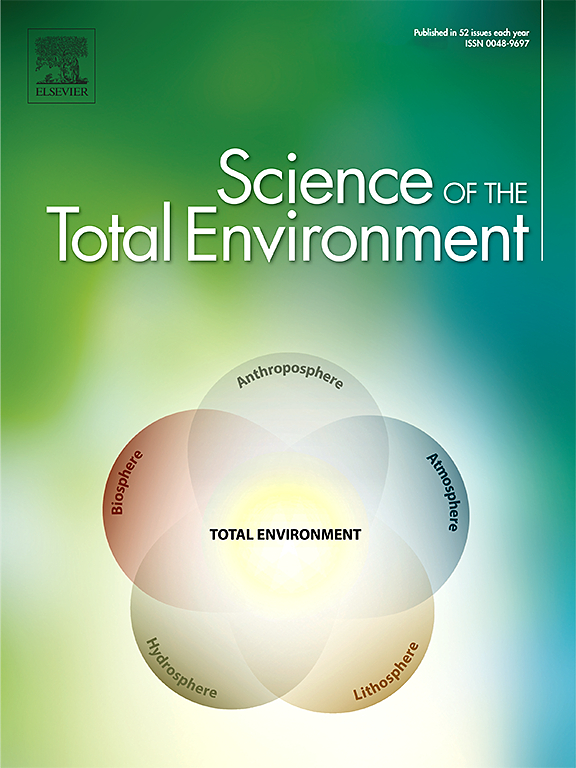Analysis of legacy PFAS and potential precursors in curtain, sofa, and carpet fabric samples
IF 8.2
1区 环境科学与生态学
Q1 ENVIRONMENTAL SCIENCES
引用次数: 0
Abstract
Per- and polyfluoroalkyl substances (PFAS) are a large group of man-made compounds used, for example, as water and oil repellents to protect textiles and fabrics. Due to a growing concern about some of these compounds, industries have introduced new PFAS varieties with supposedly less harmful properties. In this study, different fabric samples from carpets, curtains and sofas (n = 30) were analyzed after a solvent extraction and an Envi-Carb clean-up for 81 PFAS, including legacy PFAS and 43 newly synthesized precursors, mainly perfluoroalkane sulfonamide derivatives by liquid and gas chromatography – mass spectrometry. In total, 28 PFAS were detected in the fabric samples. Fluorotelomer alcohols showed the highest concentrations in the fabrics (1–2329 μg/m2). Perfluoroalkyl sulfonic acids (PFSAs) and perfluoroalkyl acids (PFAAs) were also detected but at lower concentrations (e.g., 0.02–1.71 μg/m2 for PFHxA, 0.01–1.97 μg/m2 for PFBS). Perfluoroalkane sulfonamide precursors such as MeFBSAA, FBSE, MeFBSE, FBSA, and MeFBSEA were primarily found in carpet and curtain samples, accounting for approximately 10 % and 24 % of the total PFAS concentration in these matrices, respectively. These precursors were predominantly fully fluorinated compounds with 4-carbon chains. These precursors mostly correspond to fully fluorinated 4-carbon chain-PFAS and may be in accordance with the higher use of shorter PFAS compounds observed in recent years but more samples should be tested to confirm this assumption.

窗帘、沙发和地毯织物样品中残留PFAS和潜在前体的分析
全氟和多氟烷基物质(PFAS)是一大类人造化合物,例如用作防水和防油剂,以保护纺织品和织物。由于对其中一些化合物的担忧日益增加,工业已经引入了据称危害较小的新型PFAS品种。在本研究中,对地毯、窗帘和沙发(n = 30)的不同织物样品(n = 30)进行溶剂萃取和env - carb净化后,采用液相和气相色谱-质谱法分析了81种PFAS,包括遗留的PFAS和43种新合成的前体,主要是全氟烷烃磺酰胺衍生物。织物样品中共检测到28种PFAS。织物中氟端聚体醇的浓度最高(1 ~ 2329 μg/m2)。还检测到全氟烷基磺酸(PFSAs)和全氟烷基酸(PFAAs),但浓度较低(例如,PFHxA为0.02-1.71 μg/m2, PFBS为0.01-1.97 μg/m2)。全氟烷烃磺酰胺前体如MeFBSAA、FBSE、MeFBSE、FBSA和MeFBSEA主要存在于地毯和窗帘样品中,分别占这些基质中总PFAS浓度的约10%和24%。这些前体主要是具有4碳链的全氟化合物。这些前体大多对应于全氟化的4碳链全氟磺酸,可能与近年来观察到的较短全氟磺酸化合物的更多使用相一致,但应测试更多样品以证实这一假设。
本文章由计算机程序翻译,如有差异,请以英文原文为准。
求助全文
约1分钟内获得全文
求助全文
来源期刊

Science of the Total Environment
环境科学-环境科学
CiteScore
17.60
自引率
10.20%
发文量
8726
审稿时长
2.4 months
期刊介绍:
The Science of the Total Environment is an international journal dedicated to scientific research on the environment and its interaction with humanity. It covers a wide range of disciplines and seeks to publish innovative, hypothesis-driven, and impactful research that explores the entire environment, including the atmosphere, lithosphere, hydrosphere, biosphere, and anthroposphere.
The journal's updated Aims & Scope emphasizes the importance of interdisciplinary environmental research with broad impact. Priority is given to studies that advance fundamental understanding and explore the interconnectedness of multiple environmental spheres. Field studies are preferred, while laboratory experiments must demonstrate significant methodological advancements or mechanistic insights with direct relevance to the environment.
 求助内容:
求助内容: 应助结果提醒方式:
应助结果提醒方式:


